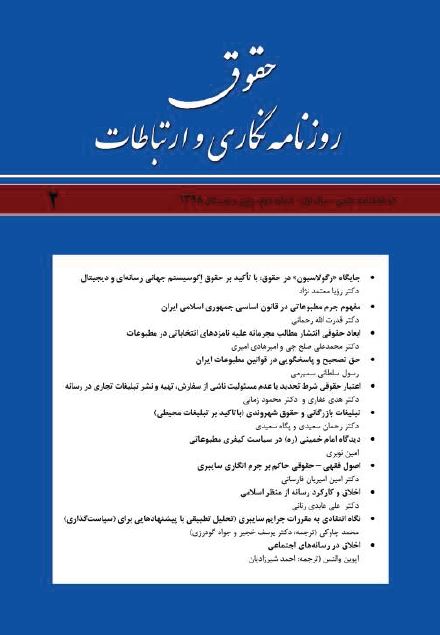فهرست مطالب

نشریه حقوق روزنامه نگاری و ارتباطات
پیاپی 2 (پاییز و زمستان 1398)
- بهای روی جلد: 550,000ريال
- تاریخ انتشار: 1398/12/22
- تعداد عناوین: 11
-
صفحه 237
-
صفحه 301
-
Page 215
The rapid advances in information technology in recent years have led to numerous gains and changes in the various dimensions of human life. Most of the daily activities of life are kind of affiliated with computers, and this addiction is increasingly being rooted every day. This great technology, which was initially exploited for the sake of the comfort and welfare of humans, has gradually become a tool for criminals in pursuit of criminal aspirations. Today, public delinquency is no longer confined to the true world. In spite of the expansion of cyber- space activities and communications, part of the perpetrators have also transferred their criminal activity to the cyber space or are committing crime or crimes through such a space. Cybercrime has increased the need for accuracy in the process of criminality due to its unique features such as ease of committing crime, transcendence of crime, criminality, widespread damage and plenty of victims. Effective and effective censorship is one of the serious concerns of the regulatory system in each country. Which empowers and strengthens the rights of the judiciary.
Keywords: jurisprudence, crime, cyber, legal principles -
Page 237
In this paper, I intend to discuss the function and ethics of media from the Islamic perspective. For this purpose, the media function and ethics will be explored form the Quran and Hadithes perspective. As will be shown, Islamic media ethics has similarities with the communitarian media ethics in which emphasis is laid upon both rights and responsibilities. In this view, the individual is not separate from the society and does not have an identity independently of the community. After discussing four theories of media ethics, including the liberal, social responsibility, interpretive and communitarian theories, I will explain the Islamic theory of media ethics. In the Islamic perspective, there is a simultaneous emphasis on rights and responsibilities. In this view, attempt is made to harmonize rights with responsibilities. The role of media in this view is to foster the common good. In the end, some indicators of Islamic media ethics will be set forth.
Keywords: Ethics, Media, Communitarianism, Islam, Rights, Responsibilities -
Page 301
Facebook, LinkedIn, Twitter, Instagram, and other social media have radically changed the ways in which organizations, groups, and individuals spread, share, and discuss ideas and information. They provide platforms for expressing opinions very rapidly to a wide audience, without interference from an editor or a group of editors. With traditional platforms like newspapers, radio, and television, the steps from formulating a viewpoint to reaching an audience with it tend to be complex and slow. The sender will usually have to convince someone with editorial powers that the message is worth publishing. This is not so with social media, where each person can be his or her own editor and immediately release personal content to an audience. From an organizational perspective, the dramatic changes in publicity options create a range of ethical challenges. This chapter provides a preliminary categorization of ethical dilemmas for users of social media based on input from professionals who are engaged in digitalization processes in their organizations.
Keywords: Social media, Facebook, Twitter, Instagram, Dilemma, Ethics

